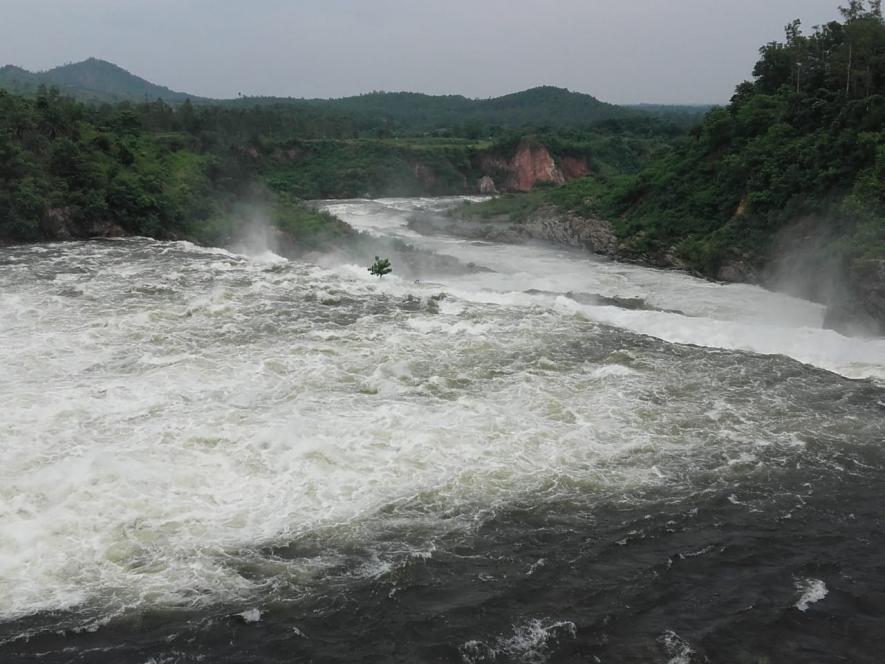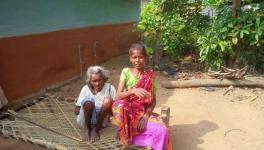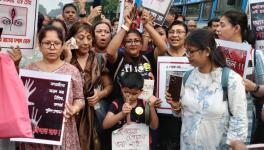Bengal: 11-Year Wait for Water for Boro Cultivation From Mukutmanipur Reservoir Continues
Kangsaboti irrigation reservoir at Mukutmonipur, Bengal
Mukutmanipur (West Bengal): Lakhindar Mahato's sigh spreads over Asia's largest earthen dam, Mukutmanipur irrigation reservoir. He is a resident of Surulia village, the adjoining area of this irrigation project. Like other years, his land did not get water for Boro (a type of rice) cultivation. The land will remain uncultivated.
About Rs 50 crore is spent annually on canal renovation and irrigation expansion. But for the past 11 years, farmers have not received irrigation water for Boro cultivation from the Mukutmanipur irrigation reservoir. The irrigation scheme was started six decades ago. The objective was to provide irrigation water to a large part of the cultivated land in Bankura, undivided Midnapore and Hooghly districts.
"For the past 10 years, nominal water has been reaching these areas. Although mentioned by Kangsaboti authority, water does not reach farmers' lands for Boro cultivation," Madhu Sudan Mahato, a marginal farmer at Sindurpur Ranibandh, told this writer.
The farmers ask if Mukutmanipur is now only a tourist centre in the eyes of the government. The location is about 250 km from Kolkata.
Surrounded by hills and forest, the gentle waves and blue water of Mukutmanipur reservoir add to the beauty of the area. Tourists would not know the plight of farmers across the reservoir, which came into existence after the eviction of many families.
In 1957, the reservoir construction began at the confluence of the Kansai and Kumari rivers flowing from Purulia. At that time, the Planning Commission approved Rs 25.26 crore for the irrigation project. As many as 372 mouzas (or villages) that belong to Bankura and Purulia districts were taken up for the Makutmanipur project. After construction started, it was named as the Kangsaboti irrigation scheme. Thousands of villages lost their lands. Most villages in the areas under the reservoir have been lost to history.
For instance, there is a Puddi gram panchayat in Ranibandh block; however, there is no Puddi village. A similar fate was served to villages like Basantopur, Dhatkidihi, Gholkuri, Bonpukuria, Serenggarh, Gonsaidihi, Bhalukchera, and Brikromdihi, among others.
"When the dam construction started, we wanted irrigation to reach our dry lands. People in Purulia and Bankura districts backed the project. We also started a movement to demand compensation, demanding that people from submerged villages should be rehabilitated and given financial compensation. The government did not accept this. We were firm because it affected thousands of people in these two districts," Bijoylakshmi Mahato, an 85-year-old local active in the Kangsaboti movement, told this writer.
Bijoylakshmi Mahato, who was active activist of Kangsaboti Movement.
"To receive compensation, a mass movement was started on the call of the undivided Communist Party of India (CPI). The movement was led by Motilal Mahato, Jaleswar Hansda, Mrityunjoy Banerjee, Gunadhar Chowdhury, Nakul Mahatos of Bankura, etc. We barricaded the car of then West Bengal chief minister Bidhan Chandra Ray who came to see the work on the reservoir. The police could not understand anything. The chief minister was forced to turn around and leave the area immediately. Police randomly arrested many people in this incident," she said.
Bijoylakshmi Mahato was arrested while pregnant and imprisoned for several months, along with her husband, Motilal Mahato. She gave birth to a child in prison. She further noted how Ray finally relented, and people received residential and farming lands in different parts of these two districts as compensation.
The irrigation scheme is constructed by diverting the Kansai and Kumari rivers' water from Purulia. It is an earthen gravity dam with a concrete saddle spillway. The bank of this reservoir is made of mud rolling in the form of a pyramid, and boulders are placed over it to protect it. Therefore, it's called Asia's largest earthen dam. Its irrigation potential of 3,48,477 hectare has been created in the districts of Bankura, West Midnapore, Jhargram and Hooghly. The project was originally planned for the Kharif season), but the then Left Front government extended the main canal, providing irrigation water for Boro cultivation.
Empty canal in Boro season at Khatra, Bankura
"The Left Front government's land reform programme provided land title deeds to landless people. Additionally, high-yielding seeds came to the market, leading to large-scale cultivation in these three districts. Kangsaboti irrigation became essential for the farmers," SK Israyel, a retired work assistant of the Kangsaboti irrigation department, told this writer.
"There was no strong demand for irrigation water before the Left Front government. After 1977, the canals were renovated, and along with Kharif and Rabi, Boro crops also started to get irrigation water,” he added.
Partha Majumdar, former chief of the zila parishad of Bankura, told this writer that "to provide irrigation water for Boro cultivation, chiefs of three districts, superintendent engineer of Kangsaboti, and government officials sat and discussed how long the water will last and distributed leaflets to inform the people of Kangsaboti irrigation area."
Many villagers that this writer talked to complained that they stopped receiving water for Boro cultivation after Trinamool Congress (TMC) came to power in West Bengal in 2011. However, they continue to pay water tax for irrigation. What is more baffling is that this discontinuation of status quo did not happen due to a rainfall decrease in the catchment area.
The reservoir can hold water up to 440 feet.
"Earlier, water was released when it reached 410 feet. The Central Water Commission (CWC) used to look after it. However, the number of workers looking after the project has decreased over the years. No new worker has been recruited in Kangsaboti for 11 years, decreasing the workforce to 20-25%. That has affected surveillance of the reservoir. Who would want to take a risk?" an assistant sub-engineer, requesting anonymity, told this writer.
"Due to the lack of surveillance, the reservoir water is released when it reaches 380 feet. That is below the danger line," he added.
Farmers of the area allege that the water gets released from the reservoir for the sand mafia and particular contractors associated with the ruling party. As the water gets released, the sand follows the course, accumulating at certain places from where the sand mafia picks it. They further allege that around Rs 50 crore gets spent on renovation, and thousands of crores have been spent in the past 11 years.

The water of Kangsaboti reservoir released unnecessarily into river
"During this period, irrigation canals were not extended anywhere. Farmers would get water during Kharif cultivation earlier. However, that has also been affected in multiple places," they said.
The farmers further explained how the whole thing is set. They highlight how only weed is left in the canal after the reservoir gets emptied, which would have to be renovated before the following year's monsoon, thereby ensuring work for contractors.
Bhaskar Surya Mandal, the superintendent engineer of Kangsaboti Division 1, said, "Due to shortage of water, the Boro farmers will not get water this year too."
No answer was received from the official when asked why the water was not retained despite the reservoir being full.
The writer covers the Bankura region for Ganashakti newspaper in West Bengal.
Get the latest reports & analysis with people's perspective on Protests, movements & deep analytical videos, discussions of the current affairs in your Telegram app. Subscribe to NewsClick's Telegram channel & get Real-Time updates on stories, as they get published on our website.
























